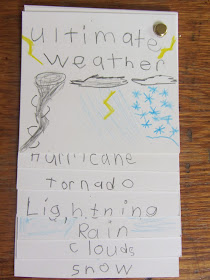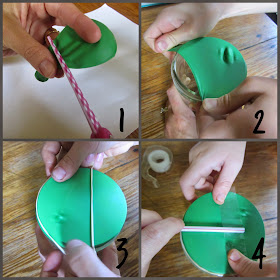This past summer, like all the summers before in our homeschooling journey, the kids and I spent our days exploring one part of God's creation. Since we live in the tundra for nearly nine months of the year, our ability to investigate nature is limited to summer time.
(This post contains affiliate links. Please see my disclosure policy for full details.)
Using some delight-directed planning, we usually choose one nature topic to investigate all summer long. This year, the children unanimously voted to learn about WEATHER.
Here are a few things we included in our three-month-long unit...
Books
Clouds (Weather)The Usborne Book of Weather Facts: Records, Lists, Facts, Comparisons
Projects
Cloud/Temperature Calendar
Every day through the month of July, we tracked the high and low temps as well as determined the type of cloud formation that was prevalent throughout the majority of the afternoon. We documented our findings on a calendar printable and glued these into our nature journals.
Weather Fact Fans
We put together a simple fact fan and designated a page for each major type of weather occurrence. As we learned about each topic, the children did a small notebook journal entry onto that particular card in their fact fans.
Water Cycle Demo Bag
After learning about the water cycle, we each drew a sketch of the process onto a ziplock bag. We poured about a cup of water into the bag, taped it to a window on a sunny side of the house, and waited. Within a day or two, we were able to see the water evaporating, condensing, and precipitating on the side of the bag.
Rain Gauge
Using the bottom half of a pop bottle, we made a simple rain gauge. We set it outside and checked it after each rain. We just happened to have an unusually wet summer this year, so there was a lot of action each week in our gauge.
Air Scale
To demonstrate the fact that air has weight, we made a simple air scale. We blew up two equal-sized balloons to two different sizes and taped them each to opposite ends of a ruler. We tied a string to the center of the ruler and held the entire contraption up by the string. Just like on a traditional scale, the ruler tipped towards the end with the heavier balloon showing that air does, in fact, have weight...the balloon with the most air weighed more.
Simple Barometer
A barometer is used to measure air pressure. While our homemade version did not tell us an exact measurement of pressure, it was able to clearly show CHANGES in pressure.
You will need:
- a glass with a wide mouth
- a balloon
- a rubber band
- scissors
- a drinking straw
- tape
- a piece of paper or cardstock and a pen
Directions:
- Cut the mouth piece off of the balloon and discard.
- Stretch the balloon over the mouth of the glass.
- Secure with a rubber band.
- Using the tape, secure the straw to the top of the balloon. The straw should be placed as close to the middle of the balloon as possible.
Use the paper or cardstock to mark the place where the end of the straw naturally rests. Check the placement of the straw end each day and mark any changes.
You should be able to see that the air pressure raises or lowers the balloon which in turn moves the end of the straw up or down.
Videos
What is a Tornado? by Monkey See
What is a Hurricane? by Monkey SeeReading Rainbow: Come a Tide- an elementary-appropriate look at dangerous weather











Super! How did you spread the unit during your summer?
ReplyDelete